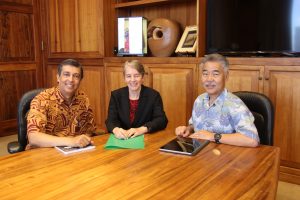From the governor: Making life better for Hawai’i’s families
Posted on Sep 26, 2017 in Capitol Connection, FeaturedHow do we help children and families in Hawai‘i thrive, not just survive? The answer lies in real, meaningful change to get better, lasting results. That’s Gov. David Ige’s challenge to state government — to find ways to work together more effectively — whether it’s cooling schools, tackling opioid abuse or adopting a new ‘Ohana Nui approach to serving families that reaches across generations. This issue looks at how fresh thinking by the Ige team is forging better results for the future.

PARTNERSHIPS: Gov. Ige with DHS director Pankaj Bhanot and DOH director Dr. Ginny Pressler at the State Capitol.
Q. Why is the new ‘Ohana Nui approach to improving services for families needed? (See story on Page 3)
A. Our goal is to break the cycle of poverty by looking at the whole family, starting with the children. That’s where a life of crime, homelessness and drug abuse — issues that affect us all — can start. With a multi-generational, ‘Ohana Nui approach, we’re looking at what we can do in a more comprehensive way across departments to help families get to a more positive place. I consider this a core value of our administration. I think Hawai‘i has always been defined by this same strong sense of ‘ohana.
Q. What makes this approach to helping families different?
A. The ‘Ohana Nui (extended family) partnership between the state departments of human services (DHS) and health (DOH) is based on my asking people to look at all the state and federal programs we provide — from food and rental assistance to services for children with special needs — and figuring out how to coordinate programs and bridge the gaps. It’s part of making the best use of our resources to get better results. We’re building teams of professionals — the ‘Ohana Nui engineers — to “engineer” change from within.
Q. How is Hawai‘i responding to the Trump administration’s policy changes and proposed budget cuts in health and human services?
A. We’re working closely with our Congressional delegation on what the impacts would be for Hawai‘i. Governors — both Democrats and Republicans — have said we want to help contain costs, but we need the authority, flexibility and time to make program changes. As the Western Governors’ Association vice-chair, I want to handle these issues in a bipartisan way to protect our citizens.
Q. How are you feeling about reaching — and exceeding — your goal of cooling 1,000 classrooms? (See story on Page 2)
A. I remember two summers ago when the heat was unbearable for both students and teachers. Thanks to support from the Legislature and the work of the Department of Education, I’m proud we not only reached but surpassed our goal of cooling classrooms with solar-powered AC and other energy-efficient tools. We’ll continue to press for funds to cool more schools statewide. Now with changes to the Green Energy Market Securitization program (GEMS), we can also use those funds to help other schools.
Read more in our October issue